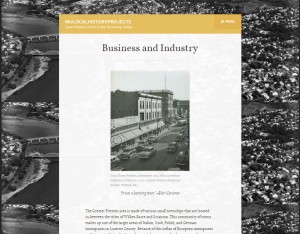Investing in public history students
08 September 2015 – Jennifer Black

Students in Black’s seminar learning collections management software in May 2015. Photo credit: Ron Faraday, Greater Pittston Historical Society
Last September, an undergraduate approached me to inquire about potential internship opportunities. As a new faculty member in a department with no formal public history program, there were few established connections with local community partners that I could tap. Yet the main obstacle to placing this student in an internship was her need for income; as a single mother, she had to support herself and her son. In fact, financial constraints often prevent history majors from engaging in educationally rich internships because they are unpaid. If we can find a way to invest in our students, however, we can provide them with worthwhile educational experiences that pack a bigger punch in terms of professional development because paid fellowships are attractive to potential employers. Recently, our university created an internal grant program that would fund undergraduate research fellows—regardless of discipline—over a ten-week summer session with generous stipends to support their nearly 30-hour work weeks. In an attempt to bring faculty-directed student research to the humanities at my university, I applied and received funding for a project that would instruct six students in public history practice, give them hands-on experience, and engage them in researching, writing, and designing an online exhibit to showcase their work.

Jim McFarland, volunteer at GPHS, briefs Black’s students on the GPHS scanning project in May 2015. Photo credit: Ron Faraday, Greater Pittston Historical Society
I partnered with the Greater Pittston Historical Society (GPHS), a local volunteer organization that had just received non-profit status. The GPHS had amassed a series of donations to build their collections but lacked the professional staff needed to process and catalog those materials. To rally public interest, the untrained volunteers at the GPHS scanned and uploaded documents and images to the GPHS Facebook page and mobilized additional volunteers to record oral histories.
The hybrid project that resulted was part research fellowship, part internship, and part classroom instruction. I drafted a project outline for our community partner that emphasized the process- (rather than product-) oriented experience I wanted for my students. I also designed a syllabus for a “Public History Practicum” course offered concurrently to the fellowship period, whose final project would be an online exhibit designed and authored by the group. My goal was to give the students a near-professional public history experience: they would catalog images, transcribe oral histories, and research and select “objects” for an online exhibit that they would design and write themselves. Even if the exhibit ultimately didn’t work, at least my students would have learned something through the process.
![Home page for Dr. Black’s student project, Mining the Past [http://mulocalhistoryprojects.org]. Image courtesy of Jennifer Black, Misericordia University.](https://ncph.org/wp-content/uploads/2015/09/MinPastHome-300x171.jpg)
Home page for Black’s student project, Mining the Past. Photo credit: Jennifer Black, Misericordia University
![Dr. Jennifer Black, center, working with Misericordia students Matt Gromala (left) and AJ Mancini (right), July 2015. Image courtesy of the Pittston Sunday Dispatch [http://psdispatch.com/].](https://ncph.org/wp-content/uploads/2015/09/image3-300x210.jpg)
Dr. Jennifer Black, center, working with Misericordia students Matt Gromala (left) and AJ Mancini (right), July 2015. Photo credit: Pittston Sunday Dispatch

Mining the Past exhibit sub-theme on Business and Industry. Photo credit: Jennifer Black, Misericordia University
The funding we received through the internal Student Summer Research Fellowship program made possible the high quality of my students’ experience and the finished product. In addition to providing the space and technology that facilitated our work, the fellowship allowed my students to devote a majority of their summer solely to this project. Had they not been paid, all of these students would have undertaken full-time jobs elsewhere to subsidize the expense of attending college. Importantly, paid fellowships evoke a competitive quality that points to the employer’s investment in training the student, and the student’s quality as a recipient of the paid position. Thus, when these students eventually enter the job market, potential employers will value their paid fellowships more than unpaid internships. Finally, the funding we received enabled us to provide a tremendous service to the community.
In just ten weeks, we accomplished what would have taken GPHS volunteers (themselves unpaid) about ten to twelve months to complete. We also gave this volunteer organization a completed exhibit that will serve them well in future publicity and fundraising efforts, saving them the expense of hiring a professional consultant to do the same. The funding infused into our project by the Student Summer Research Fellowship program instead gave that valuable experience to undergraduate students and in the process gave the university a strong ally in the community.
As we all prepare for the new academic year, we might do well to take a lesson from our colleagues in the sciences, who routinely engage undergraduates in faculty-directed research projects that provide both academic training and professional experience. Using funding like this for public history projects accomplishes several important goals. Such funding elevates the value of the public history work we do with our students by recognizing its comparability to the faculty-directed research done in other disciplines. By using the fellowship model to invest in our students’ public history education, we also strengthen our ties to the community and provide our students with a professionally valuable learning experience that is also financially solvent.
~ Jennifer M. Black is Assistant Professor of History and Government at Misericordia University. Her students’ project, “Mining the Past: Family, Faith, and Industry in Postwar Pittston,” can be found online here. Dr. Black can be reached at [email protected].



